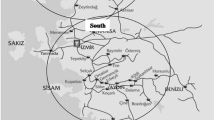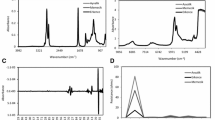Abstract
An electronic nose (e-nose), in combination with chemometrics, has been used to classify the cultivar, harvest year, and geographical origin of economically important Turkish extra virgin olive oils. The aroma fingerprints of the eight different olive oil samples [Memecik (M), Erkence (E), Gemlik (G), Ayvalık (A), Domat (D), Nizip (N), Gemlik–Edremit (GE), Ayvalık–Edremit (AE)] were obtained using an e-nose consisting a surface acoustic wave detector. Data were analyzed by principal component analysis (PCA) and discriminant function analysis (DFA). Classification of cultivars using PCA revealed that A class model was correctly discriminated from N in two harvest years. The DFA classified 100 and 97% of the samples correctly according to the cultivar in the 1st and 2nd harvest years, respectively. Successful separation among the harvest years and geographical origins were obtained. Sensory analyses were performed for determining the differences in the geographical origin of the olive oils and the preferences of the panelists. The panelists could not detect the differences among olive oils from two different regions. The cultivar, harvest year, and geographical origin of extra virgin olive oils could be discriminated successfully by the e-nose.





Similar content being viewed by others
References
Morales MT, Rios JJ, Aparicio RJ (1997) Changes in the volatile composition of virgin olive oil during oxidation: flavors and off-flavors. J Agric Food Chem 45:2666–2673
Cosio MS, Ballabio D, Benedetti S, Gigliotti C (2006) Geographical origin and authentication of extra virgin olive oils by an electronic nose in combination with artificial neural networks. Anal Chim Acta 567:202–210
Araghipour N, Colineau J, Koot A, Akkermans W, Rojas JMM, Beauchamp J, Wisthaler A, Märk TD, Downey G, Guillou C, Mannina L, van Ruth S (2008) Geographical origin classification of olive oils by PTR-MS. Food Chem 108:374–383
Angerosa F, Mostallino RC, Basti RV (2000) Virgin olive oil odour notes: their relationships with volatile compounds from the lipoxygenase pathway and secoiridoid compounds. Food Chem 68:283–287
Tura D, Prenzler PD, Bedgood DR Jr, Antolovich M, Robards K (2004) Varietal and processing effects on the volatile profile of Australian olive oils. Food Chem 84:341–349
Caporale G, Policastro S, Carlucci A, Monteleone E (2006) Consumer expectations for sensory properties in virgin olive oils. Food Qual Pref 17:116–125
Cimato A, Dello Monacoa D, Distante C, Epifani M, Siciliano P, Taurino AM, Zuppa M, Sani G (2006) Analysis of single-cultivar extra virgin olive oil by means of an electronic nose and HS-SPME/GC/MS methods. Sens. Actuators B 114:674–680
Gan HL, Che Man YB, Tan CP, NorAini I, Nazimah SAH (2005) Characterisation of vegetable oils by surface acoustic wave sensing electronic nose. Food Chem 89:507–518
Rezzi S, Axelson DE, Héberger K, Reniero F, Mariani C, Guillou C (2005) Classification of olive oils using high throughput flow 1H NMR fingerprinting with principal component analysis, linear discriminant analysis and probabilistic neural networks. Anal Chim Acta 552:13–24
Oliveros CC, Boggia R, Casale M, Armanino C, Forina M (2005) Optimization of a new headspace mass spectrometry instrument discrimination of different geographical origin olive oils. J Chromatogr A 1076:7–15
Angerosa F (2000) Sensory quality of olive oil. In: Harwood J, Aparicio R (eds) Handbook of olive oil: analysis and properties. Aspen Publishers, Gaithersburg, pp 355–356
International Olive Council (2010). http://www.internationaloliveoil.org
Vinha AF, Ferreres F, Silva BM, Valentao P, Gonçalves A, Pereria JA, Oliveira MB, Seabra RM, Andrade PB (2005) Phenolic profiles of Portuguese olive fruits (Olea europaea L.): influences of cultivar and geographical origin. Food Chem 89:561–568
Poulli KI, Mousdis GA, Georgiou CA (2005) Classification of edible and lampante virgin olive oil based on synchronous fluorescence and total luminescence spectroscopy. Anal Chim Acta 542:151–156
Eriksson L, Johansson E, Kettaneh-Wold N, Wold S (2001) Multi- and mega-variate data analysis: principles and applications. Umetrics Academy, Umeå, p 533
Meloun M, Militký J, Forina M (1992) Exploratory and factor analysis of multivariate data. In: chemometrics for analytical chemistry, Vol 1: PC-aided statistical data. Ellis Horwood, Chichester, England, pp 212–300
Gardner JW, Hines EL (1997) Pattern analysis techniques. In: Kress-Rogers E (ed) Handbook of biosensors and electronic noses, medicine, food, and the environment. CRC Press, Boca Raton, pp 633–652
Tura D, Failla O, Bassi D, Pedó S, Serraiocco A (2009) Environmental and seasonal influence on virgin olive (Olea europaea L.) oil volatiles in northern Italy. Sci Hortic 122:385–392
García-González DL, Aparicio R (2004) Classification of different quality virgin olive oils by metal-oxide sensors. Eur Food Res Technol 218:484–487
Casale M, Armanino C, Casolino C, Forina M (2007) Combining information from headspace mass spectrometry and visible spectroscopy in the classification of the Ligurian olive oils. Anal Chim Acta 589:89–95
Meilgaard M, Civille GV, Carr BT (1999) Overall difference tests VI. Same/different test (or simple difference test). In: Sensory evaluation techniques, 3rd edn. CRC Press, NY, pp 79–82
Acknowledgments
This research was supported by the Scientific and Technical Research Council of Turkey (TÜBİTAK, Project No. 104O333). The authors would like to thank the Olive Research Institute (İzmir) and the Olive Nursery (Edremit) for providing the olive samples. The authors would also like to thank the sensory panel members for their participation.
Author information
Authors and Affiliations
Corresponding author
About this article
Cite this article
Kadiroğlu, P., Korel, F. & Tokatlı, F. Classification of Turkish Extra Virgin Olive Oils by a SAW Detector Electronic Nose. J Am Oil Chem Soc 88, 639–645 (2011). https://doi.org/10.1007/s11746-010-1705-8
Received:
Revised:
Accepted:
Published:
Issue Date:
DOI: https://doi.org/10.1007/s11746-010-1705-8




